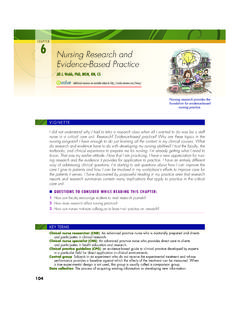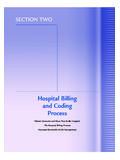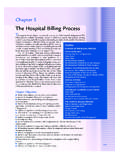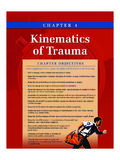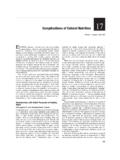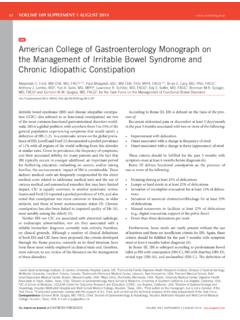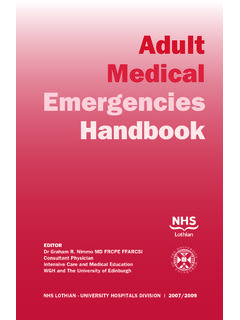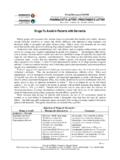Transcription of PETER L. BEYER, MS, RD, LD - Coursewareobjects.com
1 CHAPTER 30 Medical Nutrition Therapy for LowerGastrointestinal Tract DisordersPETER L. beyer , MS, RD, LDCHAPTER OUTLINE Common Intestinal Problems Diseases of the Small Intestine Intestinal Brush-Border Enzyme Deficiencies Inflammatory Bowel Diseases Disorders of the Large Intestine Intestinal SurgeryKEY TERMS705aerophagia swallowing of airblind loop syndrome a disorder of bacterial over-growth with resultant malabsorption secondary to alter-ations in the anatomy of the small intestine involving aloop that is disconnected from the main intestinal tractborborygmus intestinal rumblingceliac disease common term for gluten-sensitive en-teropathycolostomy
2 Surgical creation of an opening into thecolon through a stoma in the abdominal wall to permitdefecationconstipation a condition in which the frequency orquantity of stools is reducedCrohn s disease a chronic, granulomatous inflamma-tory disease of unknown etiology involving the small orlarge intestine that results in diarrhea, strictures, fistulas,malabsorption, and the need for surgical resectiondermatitis herpetiformis a skin disorder that is avariant of celiac diseasediarrhea abnormal volume and liquidity of stoolsdiverticulitis inflammation of diverticuladiverticulosis presence of herniations of the mucousmembrane through the muscular layers of the colonicwallfistula an abnormal passage between two internalorgans.
3 Or from an internal organ to the surface of thebodyflatulence excessive collection and passage of gasfrom the gastrointestinal tractflatus gas in the gastrointestinal tract that is expelledthrough the anusglutamine an amino acid and the preferred fuel ofthe enterocytegluten-sensitive enteropathy (celiac disease) a syn-drome precipitated by the immunologic interaction ofgluten-containing foods and intestinal cells; character-ized by flattening of the villi of the small intestinehigh-fiber diet a diet containing more than 25 g ofdietary fiberhypolactasia a decrease in the amount of the intes-tinal enzyme lactaseileostomy surgical creation of an opening into theileum through a stoma in the abdominal wallileal pouch surgical creation of a small reservoir, us-ing folds of the distal ileum, which is then attached to therectuminflammatory bowel disease (IBD)
4 A general termfor inflammatory diseases of the bowel of unknownetiology, including Crohn s disease and ulcerative colitisirritable bowel syndrome (IBS) an abnormal stool-ing pattern associated with symptoms of intestinal dys-function that persists for more than 3 months of theyearCH30_Mahan_0705-0737 9/26/03 9:54 AM Page 7057065 / MEDICAL NUTRITION THERAPYD ietary modifications in disorders of the intes-tinal tract are designed to alleviate symp-toms, correct nutrient deficiencies, and,when possible, address the primary cause of diffi-culty.
5 In disease, assessment of the nature and sever-ity of the primary gastrointestinal problem precedestargeted medical, nutrition, and other forms of ther-apy. Increased intakes of energy, protein, vitamins,minerals, and electrolytes are frequently required toreplace nutrients lost as a result of impaired digestiveand absorptive capacity. Consistency, meal frequency,and other characteristics of the diet may be altered tofit the patient s needs. Medical nutrition therapy(MNT) for all patients with diseases of the intestinesmust be individualized.
6 For this reason, the principlespresented in the chapter are general Gas and FlatulencePathophysiologyIntestinal gases include nitrogen (N2), oxygen (O2),carbon dioxide (CO2), hydrogen (H2), and, in somepersons, methane (CH4). About 200 ml of gas is nor-mally present in the gastrointestinal (GI) tract, andhumans excrete an average of 700 ml each day. How-ever, the difference in the amount of intestinal gasamong individuals and from day to day variesgreatly (Strocchi and Levitt, 1998). Considerableamounts of gas may be swallowed or producedwithin the GI tract and may be absorbed across thealimentary tract into the bloodstream and expiredthrough the lungs, expelled through eructation(belching), or passed INTESTINAL PROBLEMSWhen patients complain about excessive gas, they may be referring to increased volume or fre-quency of passage of gas (flatulence).
7 They may alsobe complaining about abdominal distention orcramping pain associated with the accumulation ofgases in the upper or lower GI tract. The associationbetween the amount of gas in the GI tract perceivedby an individual and the amount actually measuredis not always accurate (Levitt et al, 1996). Inactivity,decreased GI motility, aerophagia, dietary compo-nents, and GI disorders can all contribute to theamount of intestinal gas and an individual s gas-related in the upper intestinal tract results primarilyfrom swallowing air (aerophagia)and, to a lesser ex-tent, from chemical reactions that occur during thedigestion of foods.
8 Normally, only small amounts ofswallowed air or gases dissolved in foods make theirway as far as the colon. High N2and O2concentra-tions in rectal gas, both of which are substances thatare present in the atmosphere in high concentrations,may indicate aerophagia. Aerophagia can be avoidedto some degree by eating slowly, chewing with themouth closed, and refraining from drinking gas production may occur in the stom-ach and small intestine because of bacterial fermenta-tion, particularly with the consumption of carbohy-drate, and can result in abdominal discomfort anddistention.
9 Bacterial overgrowth may occur in thestomach or small intestine with partial obstruction,with dysmotility, in immune disorders, or after someGI surgical amounts of H2and CO2 and some-times, CH4 in rectal gas with lowered fecal pH indi-cate excessive colonic bacterial fermentation and sug-gest malabsorption of a fermentable substrate. Thelactose intolerance an inability to digest lactose togalactose and glucose because of a deficiency of the en-zyme lactasemedium-chain triglycerides (MCTs) triacylglycerolswith fatty acids of 8 and 10 carbons in length shortenough to be absorbed directly into the portal bloodminimal-residue diet a diet that results in decreased fe-cal volumephytobezoars stomach obstructions composed of par-tially digested plant foodsprebiotic dietary substrates used to promote the growthof beneficial intestinal bacteriaprobiotic orally consumed source of bacteria used toreestablish the presence of beneficial intestinal florarefractory sprue celiac disease that persists even afteradherence to a strict gluten-free
10 Dietresidue the fecal contents, including bacteria and anyremaining gastrointestinal secretions and foods not di-gested or absorbedshort-bowel syndrome (SBS) a malabsorption syn-drome resulting from major resections of the small bowel;characterized by diarrhea, steatorrhea, and malnutritionsteatorrhea excessive amounts of fat in the feces, asseen in malabsorption syndromestropical sprue a syndrome of unknown etiology thatcauses diarrhea and malabsorption but is not responsive togluten-free diet therapyulcerative colitis an inflammatory disease of the colonicmucosaKEY TERMS ContinuedCH30_Mahan_0705-0737 9/26/03 9.
